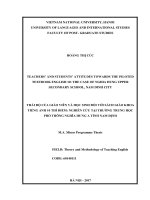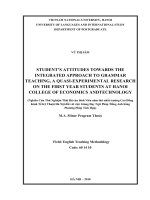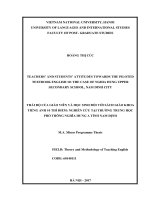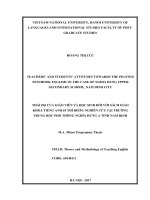3 STUDENTS’ ATTITUDES TOWARDS THE APPLICATION OF FORM-FOCUSED INSTRUCTION IN THE OMMUNICATIVE CLASSROOM ĐIỂM CAO
Bạn đang xem bản rút gọn của tài liệu. Xem và tải ngay bản đầy đủ của tài liệu tại đây (288.39 KB, 11 trang )
<span class="text_page_counter">Trang 1</span><div class="page_container" data-page="1">
<b>OF FORM-FOCUSED INSTRUCTION IN THE OMMUNICATIVE CLASSROOM</b>
<b>Lu Đinh Bao<small>1</small></b>
<i><b>Abstract: Form-focused instruction (FFI) is an effective teaching technique for </b></i>
<i>enhancing learners’ accurate oral performance. This action research aims at investigating the impacts of FFI in the communicative teaching context through students’ attitudes. In order to teach learners how to use past tenses in communication, the picture-based storytelling activity was applied in a 26-EFL-student communicative class of a university in Vietnam. During the treatment, either recast or meta-linguistic instructions, two types of FFI, was utilised to highlight the accuracy of learners’ oral performance. After 1 month, students were invited to answer a questionnaire measuring their attitude towards the application of FFI in class. The findings revealed students’ positive attitude towards FFI. However, there came 06 students providing opposite opinions. The focused-group interview was employed to clarify these students’ opinions. The yielded data proposed some recommendations for the second circle of this action research. </i>
<i><b>Keywords: form-focused instruction, Communicative language teaching, students’ </b></i>
<i>attitudes, English as a forgein language, corrective feedback </i>
<b>1. Introduction </b>
In my communicative class of freshmen of English language major in a university, although most students can express themselves by using English as a means of communication, they tend to make certain fundamentally grammatical mistakes when speaking. As reading upon the issues related to the notion of accuracy in communicative, the idea of integrating grammar in communicative classes, or form-focused instruction (FFI), appears to meet my purposes. Spada (1997) put forward the effectiveness of FFI in arousing learners’ attention to form in the communicative classroom, potentially resulting in the status of accuracy in speaking. Also, much recent research has advocated for this positive impact (Mochizuki & Ortega, 2008; Rezaei & Derakhshan, 2011; Profozic, 2013); therefore, FFI could be considered as the promising solution to the on-going troublesome teaching scenario. Thus, I decided to carry out an action research (AR) on the effect of the application of FFI in my current communicative class to find a solution for my teaching context.
From the intended purposes, the research was restricted in the scope of employing the attitudes of my current learners to measure the FFI’s impacts. Additionally, the boundaries of the attitudes’ exploration include three main components, namely emotion, behaviour, and cognition (Jain, 2014). My research question is:
<small>1. MA, Van Lang University</small>
</div><span class="text_page_counter">Trang 2</span><div class="page_container" data-page="2"><i>What are the attitudes of freshmen EFL students towards the application of form-focused instruction on their communicative class? </i>
<b>2. Literature review </b>
<i><b>2.1. FFI techniques </b></i>
Among FFI techniques, Corrective Feedback (CF) has always been under the spotlight of either scholars or practitioners in language education (Ellis, 2016). This attention could be retrieved from the nature of language teaching and learning, in which teachers tend to provide feedback on students’ errors. Also, people are in favour of CF due to its confirmative effectiveness in arousing learners’ concentration on form in communicative contexts.
The most implicit CF type, i.e. recast, is highly supported by Long (2007) as he pointed out that recast provides opportunities for immediately correcting errors without the necessity of interrupting the on-going communicative activities. However, if learners fail to recognise their errors as they are too minor or non salient, recast technique is less likely to be effective. On the other hand, meta-linguistic feedback, the most explicit CF type, on account of its intelligible influence on both correcting and highlighting essential form in communicative interactions. Saito and Loewen (2018) indicated that the solely utilising of implicit CF seems not to fully effective. Instead, they suggested combining both implicit and explicit CF so as to maximise the positive influence of FFI in CLT teaching. Therefore, recast and metalinguistic CF, the two most implicit and explicit instructional CF types (Ellis, 2016), would be appropriate techniques for the purpose of scaling up the effectiveness of applying FFI into my teaching context.
Rezaei and Derakhshan (2011) confirmed the effectiveness of recast and metalinguistic feedback in their research. They applied these two types of FFI on three EFL classes, namely recast group, metalinguistic group, and control group with 20 students for each group. students in experiental groups worked in pairs or groups to finish the grammar activities on the target structures without teachers’ intervention of correction. They then reflected the experience of carrying out those activities by either oral or written forms and received the CF either recast or metalinguistic type, depending on their groups. In a 2013 study, Profozic also found that the two implicit types of CF, recast and clarification-requests, were quite helpful in arousing learners’ interests in the past tenses of French in the form of story retelling. 52 secondary French learning students participated in the research into three groups: recast group, clarification-request group, and the control group. The picture-based activities were introduced to 3 groups. Participants had to use the 06 pictures and some attached information to retell the story. Meanwhile, teachers provided CF for the treatment groups and no intervention was made in the control group. The task of picture-based narration is a decent selection for the target structures, past tenses. Additionally, the reviewed research of recast and metalinguistic feedback is a good reference for the current
<b>AR due to its effectiveness in not only arousing participants attraction on form but also </b>
taking further steps to correct the interval errors, either implicitly or explicitly.
</div><span class="text_page_counter">Trang 3</span><div class="page_container" data-page="3"><i><b>2.2. Students’ attitude </b></i>
Looking at the components of attitude, Jain (2014) generalised the common ground among models of attitude with three components, namely affective, behavioural and cognitive components. Affective component relates to the extent to which individuals respond emotionally to the phenomena or objects. Behavioural component reflects the way the attitude affects people’s act and behave, while cognitive component involves personal belief about the object or phenomenon. To be more specific, Eshghinejad (2016) contextualised these components into ELT contexts. He described the affective component as the target language attitude, including the emotional bond between the importance of the target language and the nature of learners themselves. Correlatively, the behavioural component involves to what extent the knowledge of the target language helps learners solve concurrent problems. Cognitive component deals with learners’ beliefs towards the knowledge of the target language. My research question could be investigated in theses three components of Eshghineja to comprehensively analyse and synthesise students’ attitude towards the application of FFI in their communicative class.
<b>3. Methodology </b>
<i><b>3.1. Setting and participants </b></i>
The research was conducted in a communicative class, namely “speaking 1” class, of first-year tertiary students majoring in the English language of a university. The speaking class comprised of 24 sessions, 90 minutes each, for 12 weeks. At the end of this class, students were expected to tell stories using past, present and future tenses There come 26 students in the class. All of them are ranked at the elementary level based on the result of the school proficiency entrance test. Prior to “speaking 1” class, these students had learned past tenses grammar point, at high school and had been revised at the initial session of the course ‘speaking 1’.
<i><b>3.2. The plan for applying FFI </b></i>
The FFI was applied in 4 weeks, 2 sessions per week, for the purpose of helping students tell a story using the simple past and past perfect tenses in an appropriate way. The objective was thorough FFI activities, students could use the mentioned tenses to tell stories by picture-based narratition.
<i><b>3.3. Method for data collection and analysis </b></i>
After 1 month of applying the FFI, I continued with the data collecting stage. For this AR, the procedure of collection data was devided into two stages, the quantitative stage following up by qualitative one.
At the initial stage, a questionnaire was employed to generalise students’ attitude to the effect of the instruction. The 5-point Likert scale questionnaire, adapted from the works of Eshghinejad (2016), was focused on investigating three aspects, namely emotion, the behaviour and cognition<small>.</small> The data of the questionnaire was analysed by using the software
</div><span class="text_page_counter">Trang 4</span><div class="page_container" data-page="4">SPSS of IBM (version 23) and put forward in the format of statistical tables. After 04 weeks, 06 students were conveniently invited to respond to the piloting questionnaire. The yielded data was examined the reliability of the questionnaire with Cronbach’s alpha statistic. Inconsistent items were excluded from the official questionnaire. Eventually, the official questionnaire was delivered to the rest of the class. The data was then tested the consistency among items using Cronbach’s alpha to eliminated biased items. In addition, as the population of the research was quite small, the data of 06 piloting students, after deleted biased items, was included in the final data of the questionnaire. The result of the questionnaire helped inform my query of the impact of the application of FFI in my teaching context. Furthermore, based on the statistic data, I would carefully look at some salient opinions or negative responses.
For the secondary investigation, the focus group interview was utilised to learn more about specific attitudes towards the application from the questionnaire. This stage was an effective supplement for the first one in order to fully respond to the research questions. The informal communication with semi-structured questions was conducted in one hour focusing on groups of participants, who shared different attitudes to the whole popluation. The data for the second stage, collected by note-taking, was synthesised and presented in the form of themed responses.
</div><span class="text_page_counter">Trang 5</span><div class="page_container" data-page="5">Table 2. Item-Total Statistics - behavioural aspect
Table 1, 2, 3 presented the overall Cronbach’s alpha coefficient of 06 students. Although the coefficient figures of the three components are around 0.8 which indicates a high level of reliability, item Q9 in table 1 should be deleted as its corrected item-total correlation is under 0.3. Likewise, item Q16 in table 2 and Q24 in table 3 were excluded so as to increase the internal consistency of behavioural and cognitive items. In brief, from the piloting data, three items, Q9, Q16, and Q24, were deleted from the questionnaire.
<i>4.1.2. Official collecting stage</i>
Table 4. Item-Total Statistics- emotional aspect
</div><span class="text_page_counter">Trang 6</span><div class="page_container" data-page="6">Table 4, 5, 6 presented the data of the official collecting, the set of data was high in its consistency based on the Cronbach’s alpha result of over 0.7. However,Items with the corrected item-total correlation under 0.3 should be deleted from the data set; therefore, Q2 and Q5 in table 4, Q15 and Q17 in table 5, Q25 and Q26 in table 6 were excluded in further analysing steps.
Table 7 generalised the yielded result of the quantitative stage of research. 26 investigated students revealed their positive attitude towards the application of FFI in the communicative classroom with the central tendency, performed by the median score, ranging from 4.00, agree, to 5.00, strongly agree. In other words, the participated students confirmed the effectiveness of FFI in enhancing the aspect of accuracy in their verbal use
</div><span class="text_page_counter">Trang 7</span><div class="page_container" data-page="7">of past tenses to tell stories. Nevertheless, looking at the standard deviation scores of each item, although the majority of learners agreed on the positive influence of FFI, it could be observed that Q3, Q6, Q10, Q21, and Q28 received the most diverse answers. In other to clarify these variables, the analysis of frequencies procedure was implemented using
The two following tables, 8 and 9, indicated the frequency of chosen responses for the afore-mentioned variables, in terms of emotional and cognitive aspects. In the emotional component, some students were not really comfortable when receiving CF from the teacher on their oral performances. Indeed, in items Q3, 11.5% of the participants revealed their anxiety towards teacher’s instruction on form, whereas 15.4% of students in Q6 showed their unfavourable emotion to the intervention of teachers’ feedback when they were participating in the communicative activities. Also, one student strongly objected to receiving feedbacks in front of peers. Looking at table 9, on both Q21 and Q28, there was one extreme expression on the ineffectiveness of FFI, or CF technique, on speaking proficiency, in terms of accuracy.
Based on the analysed data of Tables 8 and 9, there came 6 students who provided different opinions. Interestingly, one of them responded negatively to all 05 items. These students were invited to the following interview in which they explained the reasons for their responses and proposed adjustment for the application of FFI from their perspective.
</div><span class="text_page_counter">Trang 8</span><div class="page_container" data-page="8">Table 8. Frequencies of Students’ emotional responses
Items Statements Frequency Percent Valid <sub>Percent</sub> <sup>Cumulative </sup><sub>Percent</sub>
Table 9. Frequencies of Students’ cognitive responses
Items Statements Frequency Percent Valid <sub>Percent</sub> <sup>Cumulative </sup><sub>Percent</sub>
The teacher should not provide corrective
<i>4.2.1. The sense of losing face </i>
All investigated students revealed their negative attitudes towards CF as they felt embarrassed when being pointed out errors in front of the class. Actually, this results
</div><span class="text_page_counter">Trang 9</span><div class="page_container" data-page="9">in the two distinct types of reaction to activities related to FFI. Firstly, students with the lower level of speaking proficiency described their anxiety before, during and even after attending communicative activities, the picture-based telling story. The teacher is suggested applying such stages as review the learned target language structures, or some rehearsal activities prior to the FFI activities. In their opinions, by carrying out the pre-task planning technique, these deficient learners would be less anxious and be more ready to not only perform the required communicative tasks but also receive feedback. These opinions reflect the claim of Mochizuki and Ortega in 2008 on the beneficial impact of pre-task planning technique. Taking this opinion into consideration, I could spend time quickly discussing and reviewing the target structure to facilitate the deficient learners in the class. However, the CF should always be the central technique of the application of FFI due to its effectiveness in enhancing accurate oral performance (Rezaei & Derakhshan, 2011; Sato & Loewen, 2018). Secondly, for more proficient learners, they did not want to be judged their performance formally. These learners proposed the possibility of receiving peers’ feedbacks first and teachers’ ones later. They argued that as classmates, their peers’ feedback is less formal than those of teachers’, resulting in a much more comfortable learning environment. Also, in case their peers’ comments are not really correct, the teachers should take actions to help them. By receiving feedback together with peers on similar errors, the process would appear to be less pressure, lessening the sense of losing faces. This proposal reflects Ellis’s statement (2016) that the applying of CF could go beyond the traditional language teaching process, in which teachers provide feedback on students’ errors. Actually, Ellis inclined towards the learner-centred classroom, in which students provide feedback to their friends. This could exert an incentive to both feedback providers and receivers as students are catered for more spaces for practice their oral performance. Also, since all students get used to the process of CF after one month of experiencing, they could provide useful comment to their friends’ work, otherwise I could take actions to facilitate them when needed.
<i>4.2.2. The preference of meta-linguistic feedback over recast </i>
Although all interviewed students expressed their either discomfort or anxiety towards CF, 04 out of 05 informants specifically expressed their interests in the meta-linguistic type of CF over recast. This interest was rationalised due to the time of providing CF. Actually, meta- linguistic CF happens after students’ oral performance, which is a less interfered instruction, in the comparison to recast, happening in the course of performance. It is important to note that the students’ opinion relatively contradicts to Long’s statement (2007) as he considered recast as an immediate technique to correct learners’ errors without interrupting their performance. Also, 04 students agreed that meta-linguistic CF is more feasible to help pique learners’ attention on the target form, which they usually make errors. In brief, based to interviewees’ responses, the consideration of recast as a non-interfered technique might be further scrutinised. Meanwhile, meta-linguistic instruction seems to fit these investigated learners since it did not interrupt their oral performance.
</div><span class="text_page_counter">Trang 10</span><div class="page_container" data-page="10"><i>4.2.3. Being able to recognised the errors, but failing to correct them </i>
Interestingly, most interviewed students were able to correct their errors based on received feedback, but one who always find it is such a challenge to correct errors albeit his awareness of these types of error yielding form CF. As further discussed on this issue, he shared that as he carried out the picture-cued story telling activities, using past tenses, some errors seemed to constantly happen despite his carefulness. Generally, the FFI, CF technique, was successfully employed to raised learners’ awareness on form, resulting in their concentration on self-correcting these errors. However, for fossilised errors, it requires a certain mouth of time and efforts to overcome the errors, mostly caused by the negative transfer of knowledge from L1 to L2.
<b>5. Conclusion </b>
This AR investigates students’ attitude towards the application of FFI in a communicative classroom. The survey design with QUAN-qual model was employed to shed light on the research question.The qualitative data, collected by the instrument of note- taking, was analysed and synthesised into themes. The result pointed out that most students revealed their positive attitude towards what they had experienced on FFI in the communicative classroom context, which confirmed the work of Saito and Loewen (2018). However, certain negative responses were spotted, especially in the emotional sector. These students disclosed their either anxiety or discomfort when receiving teacher’s feedback which could potential leads to the sense of losing face in front of classmates. Interestingly, the found emotional reactions are somewhat related to learners’ competence. Actually, the lower level of proficiency learners maintained the feeling of anxiety, whereas more proficient students expressed their uncomfortable emotions. In addition, some interviewees showed their interests in the meta- linguistic type of CF technique over that of recast since recast technique somehow interfered their oral performance, resulting in certain hesitation when using English to communicate. Finally, one student shared his failure of correcting the errors of which he had been aware. In other words, the solely implement of CF techniques seem to be inadequate for such fossilised errors emerging during the process of communication. The analysed results proposed some implications for the second round of AR: implementing peers’ feedback and emphasising pre-teaching activities. The study contains obvious limitations in terms of small-scale population. Also despite the positive attitude of students to FFI, the research need another statistic study to compare and contrast the result, i.e. studies on learners’ oral performance.
<i>[1] Ellis, R. (2016). Focus on form: A critical review. Language Teaching Research, 20(3), </i>
405-428.
[2] Eshghinejad, S. (2016). EFL students’ attitudes toward learning English language: The
<i>case study of Kashan University students. Cogent Education, 3(1). </i>
</div>








